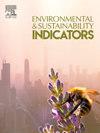Patterns and drivers of water-land resources nexus in arid inland river basins of northwestern China
IF 5.4
Q1 ENVIRONMENTAL SCIENCES
引用次数: 0
Abstract
The underlying land surface structure is being reshaped by climate change and human activities, which in turn affects the hydrological processes. However, the patterns and drivers of water and land resources nexus (WLN) in arid inland river basins remain less understood. In this study, we evaluated and predicted water and land resource dynamics by combining the soil quality index function with MCE-CA-Markov and SWAT models. We further constructed the Water-Land Nexus Model (WLNM) for water conservation and consumption zones to quantify responses of WLN to climate and land-use changes in inland river basins. Results showed that the water-land nexus index (WLNI) exhibited decreasing trend from headwaters (water conservation area) to middle and lower reaches (water consumption area). The WLNI decreased in both water conservation and consumption area from 1980 to 2000, with an area-weighted average varying from 0.1105 to 0.1071 for whole basin. It was predicted that the WLNI shows an increasing trend in water conservation area while a decreasing trend in consumption area from 2020 to 2050 under both the natural development (NDS) and ecological protection scenarios (EPS). The Geo-detector analysis showed that soil organic carbon, soil pH and mean annual precipitation are main factors affecting the spatial pattern of WLNI. Furthermore, interactions between natural and socio-economic factors exerted stronger effects on WLNI variations than that of each individual factor, highlighting the importance of interactions between natural factors and human activities in altering water-land resources nexus in arid inland basins.
西北干旱区内陆河流域水土资源联系格局及其驱动因素
气候变化和人类活动正在重塑底层的陆地表面结构,这反过来又影响了水文过程。然而,干旱区内陆河流域水土资源联系的格局和驱动因素尚不清楚。在本研究中,我们将土壤质量指数函数与MCE-CA-Markov模型和SWAT模型相结合,对水土资源动态进行评价和预测。在此基础上,构建了内陆河流域水资源涵养区和耗水区的水陆关系模型(water - land Nexus Model, WLNM),以量化内陆河流域水资源涵养区和耗水区对气候和土地利用变化的响应。结果表明:水陆联系指数(WLNI)由上游(水源涵涵区)向中下游(耗水区)呈递减趋势;1980 ~ 2000年,全流域节水和用水面积加权平均值均呈下降趋势,在0.1105 ~ 0.1071之间变化。预测在自然发展和生态保护两种情景下,2020 ~ 2050年WLNI均呈现涵养面积增加、消耗面积减少的趋势。Geo-detector分析表明,土壤有机碳、土壤pH和年平均降水量是影响WLNI空间格局的主要因素。此外,自然因素和社会经济因素之间的相互作用对WLNI变化的影响大于单个因素,突出了自然因素与人类活动之间的相互作用在改变干旱内陆流域水土资源联系方面的重要性。
本文章由计算机程序翻译,如有差异,请以英文原文为准。
求助全文
约1分钟内获得全文
求助全文
来源期刊

Environmental and Sustainability Indicators
Environmental Science-Environmental Science (miscellaneous)
CiteScore
7.80
自引率
2.30%
发文量
49
审稿时长
57 days
 求助内容:
求助内容: 应助结果提醒方式:
应助结果提醒方式:


